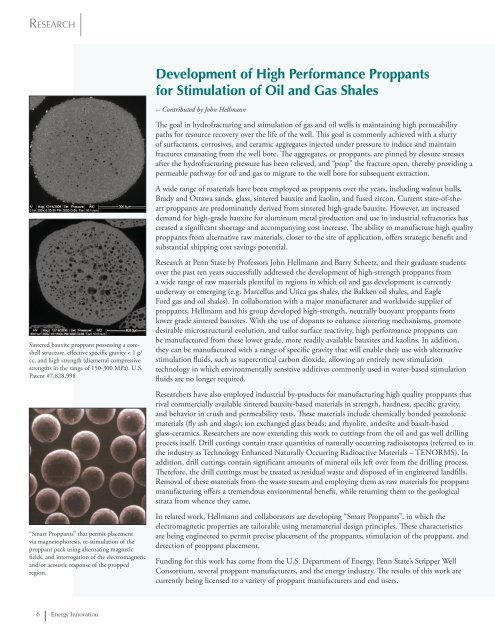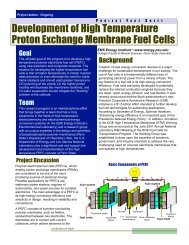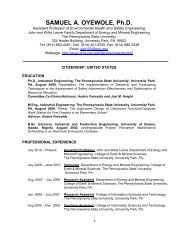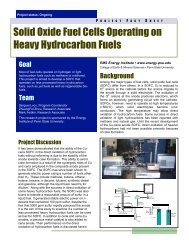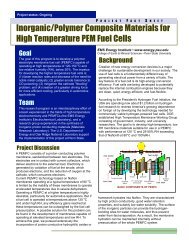Download - EMS Energy Institute - Penn State University
Download - EMS Energy Institute - Penn State University
Download - EMS Energy Institute - Penn State University
Create successful ePaper yourself
Turn your PDF publications into a flip-book with our unique Google optimized e-Paper software.
Research<br />
Development of High Performance Proppants<br />
for Stimulation of Oil and Gas Shales<br />
-- Contributed by John Hellmann<br />
The goal in hydrofracturing and stimulation of gas and oil wells is maintaining high permeability<br />
paths for resource recovery over the life of the well. This goal is commonly achieved with a slurry<br />
of surfactants, corrosives, and ceramic aggregates injected under pressure to induce and maintain<br />
fractures emanating from the well bore. The aggregates, or proppants, are pinned by closure stresses<br />
after the hydrofracturing pressure has been relieved, and “prop” the fracture open, thereby providing a<br />
permeable pathway for oil and gas to migrate to the well bore for subsequent extraction.<br />
A wide range of materials have been employed as proppants over the years, including walnut hulls,<br />
Brady and Ottawa sands, glass, sintered bauxite and kaolin, and fused zircon. Current state-of-theart<br />
proppants are predominantly derived from sintered high-grade bauxite. However, an increased<br />
demand for high-grade bauxite for aluminum metal production and use in industrial refractories has<br />
created a significant shortage and accompanying cost increase. The ability to manufacture high quality<br />
proppants from alternative raw materials, closer to the site of application, offers strategic benefit and<br />
substantial shipping cost savings potential.<br />
Sintered bauxite proppant possessing a coreshell<br />
structure, effective specific gravity < 1 g/<br />
cc, and high strength (diametral compressive<br />
strengths in the range of 150-300 MPa). U.S.<br />
Patent #7,828,998<br />
Research at <strong>Penn</strong> <strong>State</strong> by Professors John Hellmann and Barry Scheetz, and their graduate students<br />
over the past ten years successfully addressed the development of high-strength proppants from<br />
a wide range of raw materials plentiful in regions in which oil and gas development is currently<br />
underway or emerging (e.g. Marcellus and Utica gas shales, the Bakken oil shales, and Eagle<br />
Ford gas and oil shales). In collaboration with a major manufacturer and worldwide supplier of<br />
proppants, Hellmann and his group developed high-strength, neutrally buoyant proppants from<br />
lower grade sintered bauxites. With the use of dopants to enhance sintering mechanisms, promote<br />
desirable microstructural evolution, and tailor surface reactivity, high performance proppants can<br />
be manufactured from these lower grade, more readily available bauxites and kaolins. In addition,<br />
they can be manufactured with a range of specific gravity that will enable their use with alternative<br />
stimulation fluids, such as supercritical carbon dioxide, allowing an entirely new stimulation<br />
technology in which environmentally sensitive additives commonly used in water-based stimulation<br />
fluids are no longer required.<br />
Researchers have also employed industrial by-products for manufacturing high quality proppants that<br />
rival commercially available sintered bauxite-based materials in strength, hardness, specific gravity,<br />
and behavior in crush and permeability tests. These materials include chemically bonded pozzolonic<br />
materials (fly ash and slags); ion exchanged glass beads; and rhyolite, andesite and basalt-based<br />
glass-ceramics. Researchers are now extending this work to cuttings from the oil and gas well drilling<br />
process itself. Drill cuttings contain trace quantities of naturally occurring radioisotopes (referred to in<br />
the industry as Technology Enhanced Naturally Occurring Radioactive Materials – TENORMS). In<br />
addition, drill cuttings contain significant amounts of mineral oils left over from the drilling process.<br />
Therefore, the drill cuttings must be treated as residual waste and disposed of in engineered landfills.<br />
Removal of these materials from the waste stream and employing them as raw materials for proppant<br />
manufacturing offers a tremendous environmental benefit, while returning them to the geological<br />
strata from whence they came.<br />
“Smart Proppants” that permit placement<br />
via magnetophoresis, re-stimulation of the<br />
proppant pack using alternating magnetic<br />
fields, and interrogation of the electromagnetic<br />
and/or acoustic response of the propped<br />
region.<br />
In related work, Hellmann and collaborators are developing “Smart Proppants”, in which the<br />
electromagnetic properties are tailorable using metamaterial design principles. These characteristics<br />
are being engineered to permit precise placement of the proppants, stimulation of the proppant, and<br />
detection of proppant placement.<br />
Funding for this work has come from the U.S. Department of <strong>Energy</strong>, <strong>Penn</strong> <strong>State</strong>’s Stripper Well<br />
Consortium, several proppant manufacturers, and the energy industry. The results of this work are<br />
currently being licensed to a variety of proppant manufacturers and end users.<br />
6 <strong>Energy</strong> Innovation


